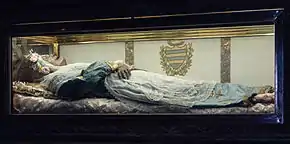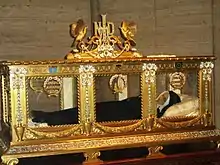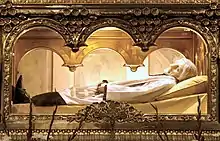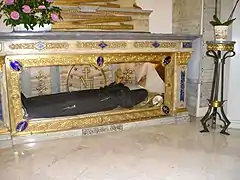
Incorruptibility is a Catholic and Eastern Orthodox belief that divine intervention allows some human bodies (specifically saints and beati) to completely or partially avoid the normal process of decomposition after death as a sign of their holiness.
Incorruptibility is thought to occur even in the presence of factors which normally hasten decomposition, as in the cases of saints Catherine of Genoa, Julie Billiart and Francis Xavier.[1]
Catholicism
In Catholicism, if a body is judged as incorruptible after death, this is most often seen as a sign that the individual is a saint. Canon law allows inspection of the body so that relics can be taken and sent to Rome. The relics must be sealed with wax and the body must be replaced after inspection. These ritual inspections are performed very rarely and can only be performed by a bishop according to the requirements of canon law. A pontifical commission can authorize inspection of the relics and demand a written report.[2] After solemn inspection of the relics, it can be decided that the body is presented in an open reliquary and displayed for veneration. Catholic law allows saints to be buried under the altar, so Mass can be celebrated above the remains.
The remains of Bernadette Soubirous were inspected multiple times, and reports by the church tribunal confirmed that the body was preserved. The opening of the coffin was attended by multiple canons, the mayor and the bishop in 1919, and repeated in 1925.[3] However, the face and hands were covered with a wax mask.[4]
Not every saint, however, is expected to have an incorruptible corpse. Although believers see incorruptibility as supernatural, it is no longer counted as a miracle in the recognition of a saint.[5]
Embalmed bodies were not recognized as incorruptibles. For example, although the body of Pope John XXIII remained in a remarkably intact state after its exhumation, Church officials remarked that the body had been embalmed[6] and additionally there was a lack of oxygen in his sealed triple coffin.[7]
Incorruptibility is seen as distinct from the good preservation of a body, or from mummification. Incorruptible bodies are often said to have the odour of sanctity, exuding a sweet or floral, pleasant aroma.
Saints
 The body of Saint Zita, found to be incorrupt by the Catholic Church. (c. 1218 – April 27, 1272).
The body of Saint Zita, found to be incorrupt by the Catholic Church. (c. 1218 – April 27, 1272). The body of Saint Rita of Cascia, found to be incorrupt by the Catholic Church. (1381 – May 22, 1457).
The body of Saint Rita of Cascia, found to be incorrupt by the Catholic Church. (1381 – May 22, 1457).
 The body of Saint Virginia Centurione, found to be incorrupt by the Catholic Church. (April 2, 1587 – December 15, 1651).
The body of Saint Virginia Centurione, found to be incorrupt by the Catholic Church. (April 2, 1587 – December 15, 1651). The body of Saint Bernadette of Lourdes with wax face and hand coverings, declared to appear incorrupt by a committee in 1909 (subsequent exhumations indicated corruption). (January 7, 1844 – April 16, 1879).
The body of Saint Bernadette of Lourdes with wax face and hand coverings, declared to appear incorrupt by a committee in 1909 (subsequent exhumations indicated corruption). (January 7, 1844 – April 16, 1879). The body of Saint John Mary Vianney wearing a wax mask, found to be incorrupt by the Catholic Church. (May 8, 1786 – August 4, 1859).
The body of Saint John Mary Vianney wearing a wax mask, found to be incorrupt by the Catholic Church. (May 8, 1786 – August 4, 1859). The body of Saint Catherine Labouré, found to be incorrupt by the Catholic Church. (May 2, 1806 – December 31, 1876).
The body of Saint Catherine Labouré, found to be incorrupt by the Catholic Church. (May 2, 1806 – December 31, 1876).
Beatified
Eastern Orthodoxy

To the Eastern Orthodox, a distinction is made between natural mummification and what is believed to be supernatural incorruptibility. While incorruptibility is not generally deemed to be a prerequisite for sainthood, there are reportedly many Eastern Orthodox saints whose bodies have been found to be incorrupt and are in much veneration. These include:
- Saint Alexander of Svir – the incorrupt relics of the saint were removed from the Svir Monastery by the Bolsheviks on December 20, 1918, after several unsuccessful attempts to confiscate them. Finally, the holy relics were sent to Petrograd's Military Medical Academy. There they remained for nearly eighty years. A second uncovering of St Alexander's relics took place in December 1997, before their return to the Svir Monastery.[8]
- Saints Anthony, John, and Eustathios
- Saint Dionysios of Zakynthos
- Saint Elizabeth
- Saint Gerasimus of Kefalonia
- Saint Ioasaph of Belgorod – In 1918 the Bolsheviks removed Saint Ioasaph's relics from his shrine in the cathedral of the Holy Trinity at Belgorod, and for some seventy years, their whereabouts remained unknown. In 1927, the cathedral itself was demolished. In the late 1980s, the relics were discovered in Leningrad's Museum of Religion and Atheism, and on 16 September 1991, they were solemnly returned to the new Cathedral of the Transfiguration of Our Lord in Belgorod, in the presence of Patriarch Alexy II.[9]
- Saint Job of Pochayiv
- Saint John Maximovitch of Shanghai and San Francisco
- Saint John the Russian
- Saint Nectarios of Aegina
- Saint Parascheva of the Balkans
- Saint Spyridon
- Saint Zosima
- Archbishop Dimitri Royster[10]
Judaism
Rabbi Louis Ginzberg in his monumental "Legends of the Jews" (Vol. 4, Chapter 10) based on the Jewish Apocrypha and Aggadah mentions an alleged case of bodily incorruptibility of the Biblical Baruch, scribe of Jeremiah (whose tomb is found in Iraq).[11] Similar stories are told of later Hasidic saints, such as Rebbe Elimelech of Lizhensk and others.
See also
Footnotes
- ↑ Quigley, Christine (2005). The Corpse: A History. McFarland. p. 254. ISBN 978-0786424498.
- ↑ http://www.pravoslavie.ru/english/print49948.htm The Re-Vesting of the Relics of St. John of Shanghai & San Francisco
- ↑ "The Body of Saint Bernadette". www.catholicpilgrims.com. Retrieved 8 April 2018.
- ↑ "The Incorrupt Body of Saint Bernadette Soubirous | Miracles | ANF Articles".
- ↑ Archived at The Incorruptibles, The bodies of many medieval Catholic saints and martyrs have resisted decay for centuries— just the sort of mystery that begs for scientific inquiry, By Heather Pringle, Discover Vol. 22 No. 6 (June 2001)
- ↑ Sandri, Luigi (1 June 2001). "Blessed John XXIII's Remains Are Now On View At St Peter's". Christianity Today. Archived from the original on 11 May 2014. Retrieved 11 February 2014.
- ↑ Tomov, Nikola. "Preserving the Pontiff: an account of the body preservation methods used by the Roman Catholic Church". Acta Morphologica et Anthropologica. 25 (1–2): 117–121.
- ↑ The Marvelous Wonderworker of All Russia, Holy Venerable Alexander of Svir. St. Petersburg: Holy Trinity Monastery of St. Alexander of Svir, 2002. Archived 2012-04-02 at the Wayback Machine
- ↑ ST. IOSAF THE DIVINE PROTECTOR at angelfire.com
- ↑ "PHOTOS: PERSONAL TESTIMONY TO ARCHBISHOP DIMITRI'S INCORRUPT RELICS". OrthoChristian.com. March 7, 2016.
- ↑ The Legends of the Jews By Louis Ginzberg. Volume 4. Chapter 10. 1909.
Literature
- Cruz, Joan Carroll (1977 and 1991). The Incorruptibles: A Study of the Incorruption of the Bodies of Various Catholic Saints and Beati, by, OCDS, TAN Books. ISBN 0-89555-066-0.
- Jeremiah, Ken (2012). Christian Mummification: An Interpretive History of the Preservation of Saints, Martyrs and Others, OCDS, McFarland & Co., Inc. ISBN 0786465190.
External links
- "Incorrupt Bodies Of the Saints". Archived from the original on 2008-06-14.
- St Dionysios of Zakynthos
- St Spyridon the Wonderworker and Bishop of Tremithus